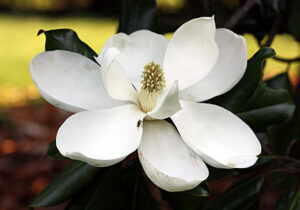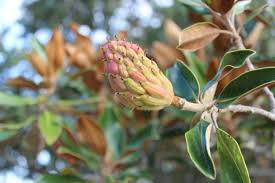Southern Magnolia, the Beautiful Grand Belle of the South
by Carolyn R. Casey, Fairfax Master Gardener
 Are you looking for a unique ornamental specimen tree that has beautiful foliage and very large, lovely, and fragrant flowers? Then the Southern Magnolia is the perfect choice. Standing alone, it commands attention as a focal point for the yard or can be placed as a glamorous screen for your yard. The tree is a symbol of magnificence due to its impressive height and enormous flowers. No other tree is quite like the Southern Magnolia with its shiny dark green leaves and beautiful large and very fragrant white flowers. It also provides shelter and food to birds and mammals.
Are you looking for a unique ornamental specimen tree that has beautiful foliage and very large, lovely, and fragrant flowers? Then the Southern Magnolia is the perfect choice. Standing alone, it commands attention as a focal point for the yard or can be placed as a glamorous screen for your yard. The tree is a symbol of magnificence due to its impressive height and enormous flowers. No other tree is quite like the Southern Magnolia with its shiny dark green leaves and beautiful large and very fragrant white flowers. It also provides shelter and food to birds and mammals.
The Southern Magnolia planted in our yard was used for not only for its beauty and fragrance but for property screening. I remember the beautiful shiny green leaves, the huge gorgeous white extremely lemon fragrant blossoms and the seed pods that when open exposed the attractive red berries inside. What a sight and fragrance to behold, stimulating the senses!
The Southern Magnolia (Magnolia grandiflora) is a handsome and durable native tree also known as Bull Bay and Large Tree Magnolia. At one time they were known as Magnolia angustifolia, Magnolia elliptica and Magnolia foetida. The magnolia is named after Pierre Magnol, a French botanist, that was so taken by the Southern Magnolia tree that he transplanted it in Europe 300 years ago.

Leaves
It is a broad leaf evergreen that grows 60 to 80 feet tall and 20 to 40 feet wide. The trunk diameter can reach 3 feet. Southern Magnolia grows into a very large tree, and it is important to keep this in mind when you select a place to plant it. Southern Magnolias have a number of dicot features (two cotyledons). The flowers may have six petals, a feature belonging to monocots. There are no diseases or insect pests that are known to attack the Southern Magnolia.
It has a conical dense shape with beautiful shiny dark green leaves that can reach 5 to 10 inches in length. The leaf’s shine is produced by the cuticle, a wax coating that prevents water loss. The Southern Magnolia has extremely attractive large white saucer-shaped, fragrant flowers that bloom in the late spring and into the summer. Southern Magnolias are angiosperms and use flowers to reproduce; they have both male and female reproductive structures. Each flower may have 6 to 12 petals and can be 6 inches across. The flower is associated with nobility, perseverance, dignity and the love of nature.
The bark of the Southern Magnolia is dark brown to dark gray and smooth when the tree is young, and it appears as close plates or scales as the tree gets older. Southern Magnolias are single trunk trees; however, they can also be grown as multi-trunk trees. They may have branches that grow all the way to the ground. The lower branches can be pruned to make it look like a tree, which makes it easier to mow around and under.
The bark has small lenticels. These are small openings in the stems of plants that allow for gas exchange, and they function like stomata. They allow for gasses to reach the inner tissue layers in the stem. The bark is a diaphoretic (it induces perspiration), a stimulant and a tonic. It is used to treat malaria, as a steroid, as an anti-anxiety medicine and to treat rheumatism. It was used as a medicine to treat circulatory system disorders. Magnolia leaves, fruit, bark and wood produce extracts that are used as medicine.

Seed pods
They have cone-shaped seed pods that are 3 to 5 inches long and mature in September to October. The seed pods and foliage are used in floral arrangements and the red seeds are eaten by birds and small mammals. Southern Magnolias provide shelter for birds and mammals during the cold winter and during storms.
According to the United States National Arboretum, Magnolias are one of the oldest known species of trees in the world. Most Southern Magnolias like rich well drained acidic soils, and they can endure elevated moisture levels. They also like a full sun to part shade environment. They grow in the southeastern United States from Maryland to west Texas and into Florida in zones 6a to 10a. They are moderately fast-growing trees that have been planted around the world and grow in warm to semitropical climates.
Southern Magnolias can be planted any time of year when they are container grown trees. Balled and burlapped trees should be planted in August to October. The hole needs to be twice the width of the root ball and as deep as the root ball. Put the tree in the hole so the surface of the root ball is a little higher than the surrounding ground. Then backfill the hole and water thoroughly and add 3 to 4 inches of water at the base of the tree. Leave the rootball exposed since mulch may keep the water from reaching the rootball. Transplant shock frequently occurs with Southern Magnolias, so it may lose a few leaves during its first season.
Regular watering will help the plant become established. After four to six weeks, apply a light fertilizer. Then apply frequent applications of fertilizer during the first three growing seasons. Apply 0.5 pound or 1 cup of 8-8-8 or 10-10-10 fertilizer around the perimeter of the planting hole in March, May and July. Apply 2 cups of fertilizer in the second year from the tips of the canopy to 3 feet beyond the canopy in March, May and July. In the third year, apply 4 cups and spread it from the tips of the canopy to 6 feet beyond the canopy in March, May and July. By the fourth year, the tree will have a well-established root system and be able to find nutrients on its own. Magnolia roots can grow more than three times further than the canopy width of the tree. This allows the tree to obtain nutrients applied to other plants and turfgrass.

Mature tree
The Southern Magnolia has light, soft and tan-colored wood that is used commercially for veneer, furniture, pallets, paper pulp and flake and chip boards.
Southern Magnolias have several cultivars and varieties. Most of the cultivars are seedling selections that are vegetatively propagated. This leads to an extensive range of tree shapes, leaf colors and sizes. It can take tree seedlings up to 10 years or more to flower. New cultivars flower at an earlier age. They have tighter, denser canopies or a small growth habit than seedling forms. There are even dwarf varieties available. One example of a magnolia dwarf variety is Little Gem. It is a dwarf cultivar and a great choice for smaller gardens and yards. It will take 15 years for it to grow 12 feet, and it flowers at a younger age. It is an upright narrow tree with smaller leaves and flowers than the usual varieties.
The traditional Southern Magnolia makes a great addition to yards and gardens that can accommodate its large size. If you aren’t able to fit a Southern Magnolia into your landscape, then one of its many cultivars or varieties like Little Gem will make a beautiful and fragrant addition to your landscaping. The Southern Magnolia is truly the Belle of the South. Happy gardening, ya’ll.
References
Magnolia grandiflora, North Carolina Extension Gardener Plant Toolbox
Southern Magnolia, University of Florida
Growing Southern Magnolia, University of Georgia Extension
Southern Magnolia, Yale University
Southern Magnolia, Alex X. Niemiera, Virginia Cooperative Extension